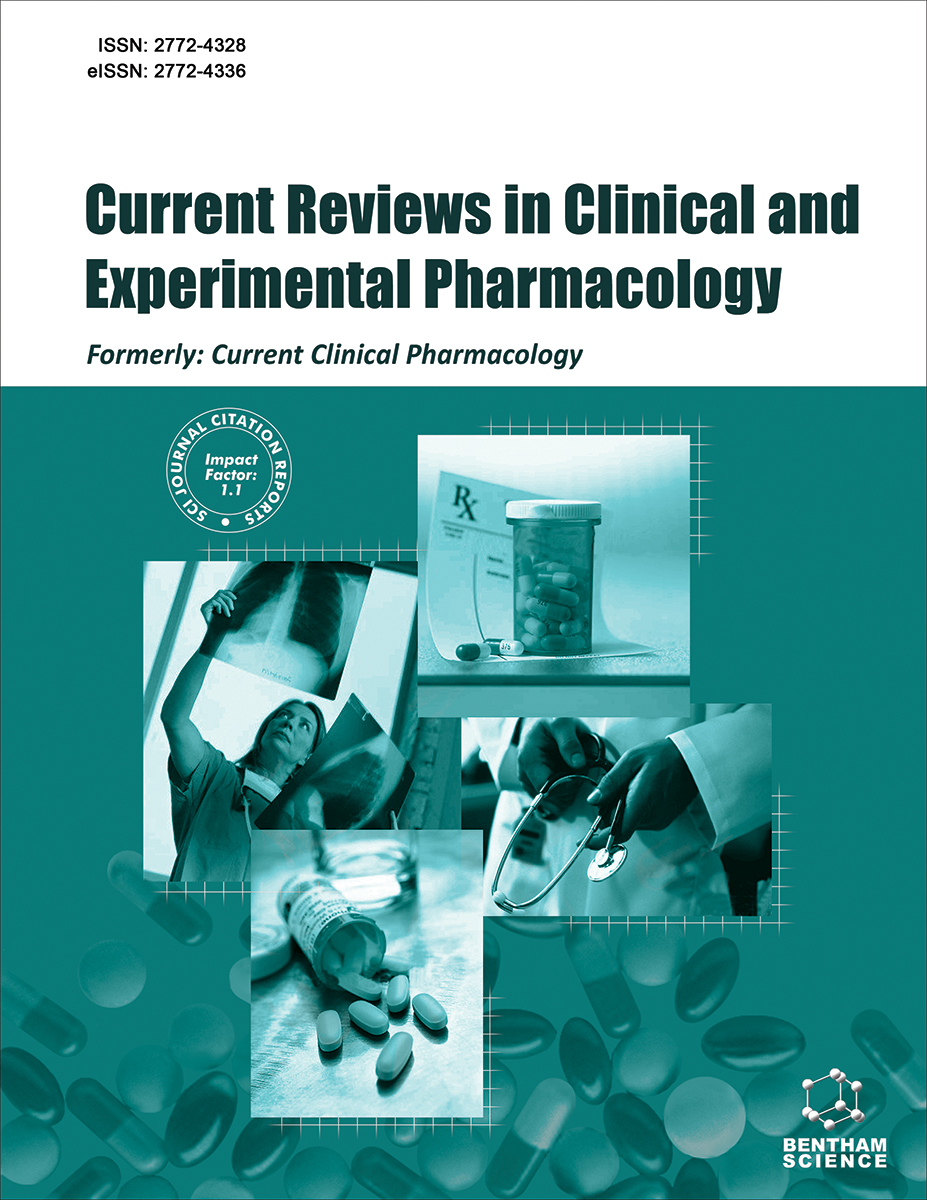- Home
- A-Z Publications
- Current Reviews in Clinical and Experimental Pharmacology
- Previous Issues
- Volume 19, Issue 1, 2024
Current Reviews in Clinical and Experimental Pharmacology - Volume 19, Issue 1, 2024
Volume 19, Issue 1, 2024
- Pharmacology
-
-
-
A Candidate for Health Promotion, Disease Prevention and Treatment: Common Rue (Ruta graveolens L.), an Important Medicinal Plant in Traditional Medicine
More LessBackground: Ruta graveolens L. belongs to Rutaceae; it is a semi-wood perennial or a small evergreen sub-shrub, which is native to Southern Europe, West Asia and Northern Africa.Objective: The goal of this manuscript was to outline the most notable traditional and modern advantages and pharmaceutical benefits of common rue.Methods: The manuscript covers review articles, randomized control experiments, analytic Read More
-
-
-
A Review of Preclinical Tools to Validate Anti-Diarrheal Agents
More LessBackground: Since their inception, preclinical experimental models have played an important role in investigating and characterizing disease pathogenesis. These in vivo, ex vivo, and in vitro preclinical tests also aid in identifying targets, evaluating potential therapeutic drugs, and validating treatment protocols.Introduction: Diarrhea is a leading cause of mortality and morbidity, particularly among children in develo Read More
-
-
-
COVID-19 Vaccination Hesitancy: A Review of the Literature and Recommendations
More LessVaccines are important to improve immunity against pathogens and diseases. The current COVID-19 disease is rapidly evolving and spreading among people; therefore, it is important to utilize a proper vaccination strategy against it. Currently, many approved vaccines are available and accessible; however, there is a reported hesitancy against taking them among the public and even the health care workers. Mainly, this i Read More
-
-
-
Effects of Drugs and Chemotherapeutic Agents on Dental Implant Osseointegration: A Narrative Review
More LessBackground: Dental implants have been one of the most popular treatments for rehabilitating individuals with single missing teeth or fully edentulous jaws since their introduction. As more implant patients are well-aged and take several medications due to various systemic conditions, clinicians should take into consideration the possible drug implications on bone remodeling and osseointegration.Objective: The present Read More
-
-
-
Clinical Studies that Initiated the Use of Spinal Opioids for the Treatment of Pain: A New Approach to Historical Review
More LessBy Igor KissinOpioids administered into the spinal space by intrathecal or epidural routes can provide potent and prolonged selective analgesia. Compared to the systemic administration of opioids, spinal administration can bring about analgesia with fewer central and systemic adverse effects. For the past 40 years, spinal opioid analgesia has achieved great popularity in various fields of pain treatment. The aim of this work is to identify clinical Read More
-
-
-
New Strategies in the Treatment of Diseases Caused by Acanthamoeba Based on Nanoparticles: A Systematic Review
More LessBackground: Acanthamoeba is one of the opportunistic parasites with a global prevalence. Currently, due to the side effects and the emergence of drug resistance to this parasite, much research has been performed on the use of nano-drugs to treat Acanthamoeba-caused diseases. Therefore, this systematic review study aims to evaluate new strategies for treating diseases caused by Acanthamoeba based on nanoparticles (NP Read More
-
-
-
Current Status of Pharmacokinetic Research in Children: A Systematic Review of Clinical Trial Records
More LessBackground: Many medications have different pharmacokinetics in children than in adults. Knowledge about the safety and efficacy of medications in children requires research into the pharmacokinetic profiles of children's medicines. By analysing registered clinical trial records, this study determined how frequently pharmacokinetic data is gathered in paediatric drug trials.Methods: We searched for the pharmacokinetic da Read More
-
-
-
Cystic Fibrosis Transmembrane Conductance Regulator Protein Modulators in Children and Adolescents with Different CF Genotypes - Systematic Review and Meta-Analysis
More LessObjective: To determine the efficacy of the first triple CFTR protein modulators in children and adolescents with cystic fibrosis.Methods: Systematic review and meta-analysis were conducted, following PRISMA guidelines. The following databases were searched extensively: PubMed/Medline, Clinical trials.gov, Google Scholar, Scopus, Embase, and Europe PMC using the keywords: “Ivacaftor”, “Elexacaftor”, “Tezacaftor”, VX_66 Read More
-
-
-
Effect of Probiotics on Urinary Tract Infections in Children: A Systematic Review and Meta-Analysis
More LessAuthors: Elham Emami, Catherine MT Sherwin and Saeid Heidari-SoureshjaniBackground: Urinary tract infections (UTIs) are the most prevalent bacterial infections that occur in children worldwide.Objective: This meta-analysis aims to investigate the utility of probiotics as preventive therapy in children with a UTI.Methods: The Web of Science, PubMed, and Scopus were searched for articles that investigated the relationship between probiotic consumption and the risk of UTIs. The quality of the articl Read More
-
Most Read This Month
Article
content/journals/crcep
Journal
10
5
false
en


